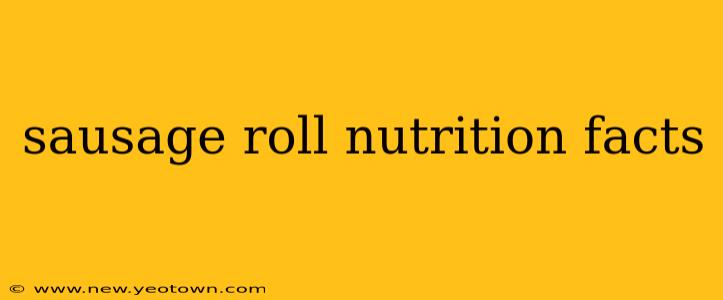Decoding the Deliciousness: A Deep Dive into Sausage Roll Nutrition
Sausage rolls. The quintessential comfort food, a picnic staple, a lunchtime delight. But how much do we really know about what's inside that flaky pastry? Let's unravel the nutritional facts behind this beloved baked treat, exploring everything from calories and fat to protein and potential health impacts. This isn't just about numbers; it's about understanding how to enjoy sausage rolls mindfully.
My name's Amelia, and I've spent years researching food science and nutrition, specifically focusing on the nutritional breakdown of popular snacks and comfort foods. This isn't just about the numbers; it’s about understanding how sausage roll ingredients affect your body. I’ll guide you through the nutritional landscape, tackling common questions along the way.
What are the calories in a sausage roll?
This is the big question, isn't it? The calorie count of a sausage roll varies wildly depending on size, brand, and ingredients. A typical small sausage roll might contain anywhere from 200 to 350 calories. Larger rolls, or those made with richer pastry and more sausage meat, can easily top 400 calories. Think of it this way: that seemingly innocent snack can pack a surprising caloric punch! It's crucial to check the specific nutritional information on the packaging of the brand you are consuming.
How much fat is in a sausage roll?
Fat is another significant factor. Sausage rolls are inherently high in fat due to the pastry and the sausage meat itself. A large portion of this fat is saturated fat, which, in excess, can contribute to high cholesterol. Again, the exact amount varies but expect a substantial amount—often exceeding 15 grams per roll, sometimes reaching 25 grams or more. Mindful portion control is key here.
What about the protein and carbohydrates in a sausage roll?
While sausage rolls are not a primary source of protein, they do offer a moderate amount, usually around 5-10 grams per roll. The protein mainly comes from the sausage meat. Carbohydrates largely stem from the pastry, providing quick energy but also contributing to the overall calorie count. The carbohydrate content can vary significantly, but generally falls in the 20-30 gram range per sausage roll.
Are sausage rolls healthy?
Ah, the million-dollar question. The short answer is: it depends. Sausage rolls, in moderation, aren't inherently "unhealthy," but they shouldn't be a daily staple. The high fat and calorie content means they should be enjoyed as an occasional treat rather than a regular part of a balanced diet. Opting for smaller rolls or those made with leaner meat and less saturated fat can help mitigate some of the negative impacts.
What are the ingredients in a sausage roll?
Typically, a sausage roll includes a pastry casing (usually puff pastry or shortcrust) and a sausage meat filling. The sausage meat is typically a mixture of ground pork, beef, or a combination, along with seasonings, binders, and sometimes other ingredients. However, ingredients can vary dramatically between brands, so always read the label carefully to understand the specific components of your chosen sausage roll. Pay close attention to added sugar and sodium levels.
How can I make healthier sausage rolls?
You can absolutely make healthier sausage rolls! Use whole-wheat pastry for extra fiber, opt for leaner ground meat in the filling, incorporate more vegetables for added nutrients, and reduce the amount of salt and fat. Homemade sausage rolls give you complete control over the ingredients and allow you to tailor them to your dietary needs and preferences.
In conclusion, sausage rolls are a delicious treat, but awareness of their nutritional content is vital for mindful enjoyment. By understanding the calorie, fat, protein, and carbohydrate breakdown, you can make informed choices and savor this classic snack without overindulging. Remember, moderation is key, and homemade alternatives offer a great path toward healthier enjoyment.

